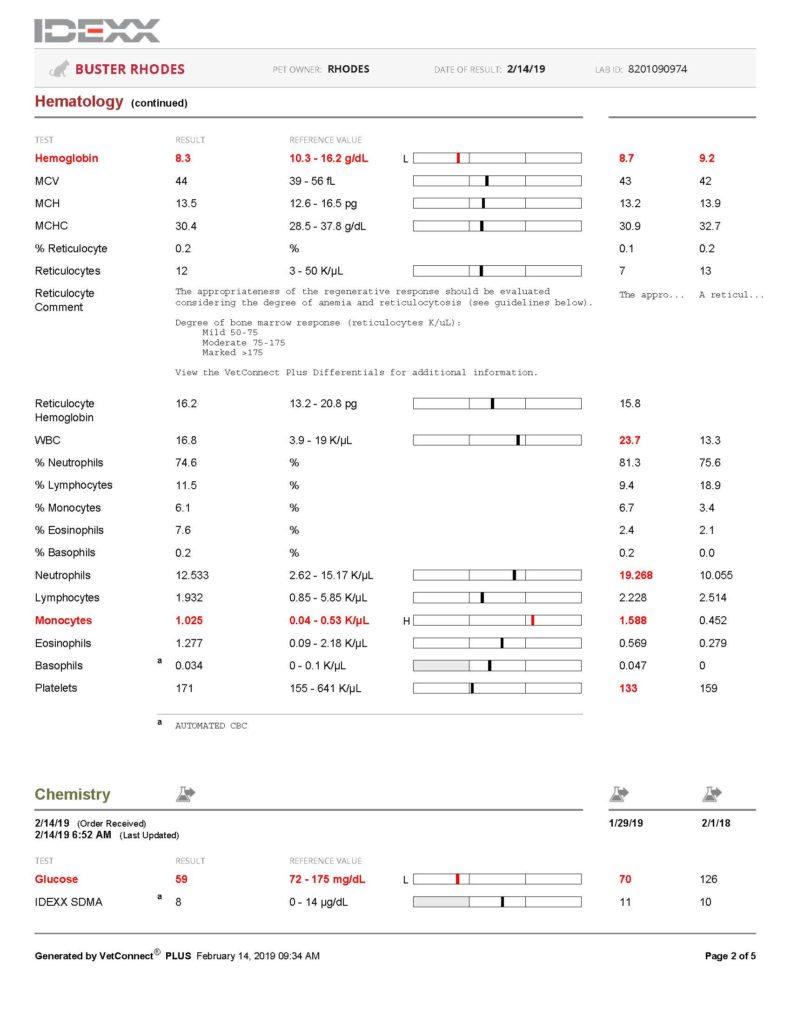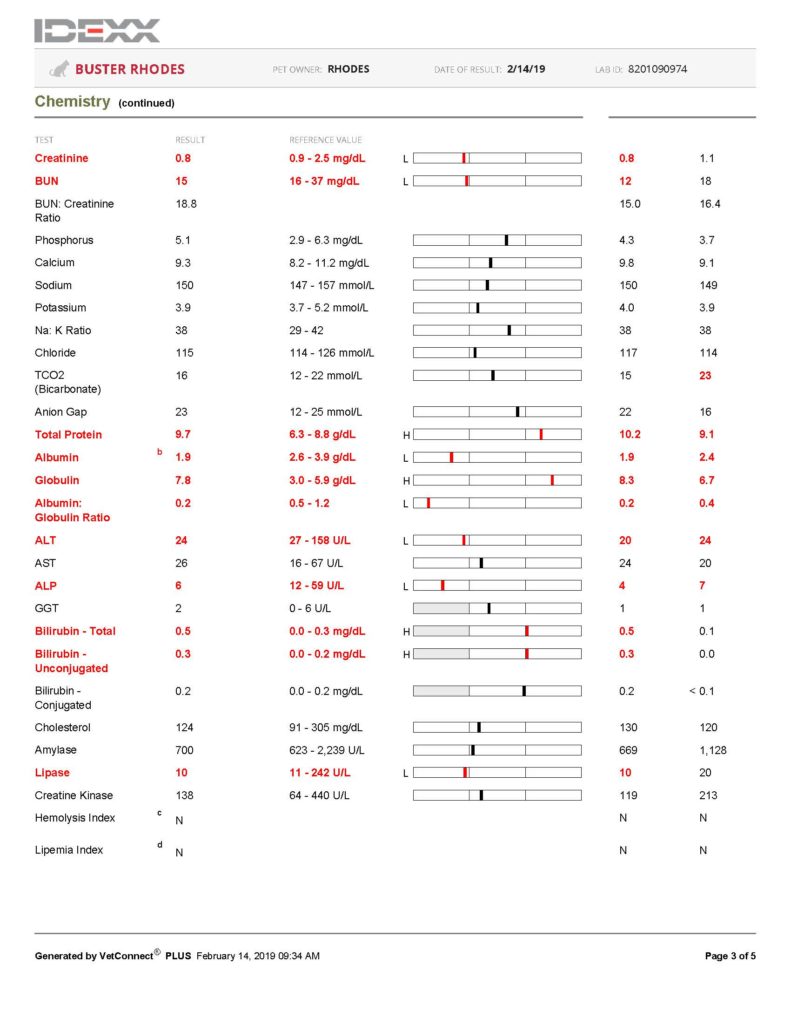This page will explain what to look for in your cat’s blood tests when trying to diagnose FIP or when tracking progress during treatment. My own cat’s blood tests turned out to be pretty much textbook so I will use them as an example. Nothing in the blood 100% proves your cat has FIP but if your cat shows certain markers and you combine that with FIP symptoms, the diagnosis can certainly be certain enough to justify starting to treat with GS.
What tests do I need? You don’t need a bunch of fancy tests. You will want to make sure your vet does Complete Blood Count (CBC) and Full Chemistry (Chem). Some Vets have “in house” testing capability but those tests often don’t test for all the required makers. The advantage is you get the results quicker. You are probably going to want the more complete “send out” testing. In my experience, those results come back the next morning after the sample is taken.
There are four maker sets
Two of the marker sets are in CBC and two are in Chem.
- Red blood cell markers (CBC): Low Hemotocrit (HCT), low Red Blood Cells (RBC), and low Hemoglobin (HMG). Very often we see all three clustered near or below the low end of normal. This is a type of Anemia that FIP causes. B12 will not help this type of anemia but it will resolve with GS treatment. As you progress with treatment, look for all three to come back up in the normal range.
- White blood cell levels: Low Lymphocytes, low %Lymphocytes, high Neutrophils, high %Neutrophils. FIP can affect the white blood cells. White blood cell levels are reported in two ways: absolute levels and percentage levels. The classic FIP pattern is low Lymphocytes and high Neutrophils. However, quite often the absolute levels will still be in the normal range but you can see the effect of FIP in the percent levels. The Percent levels should be near 40% for both Lymphocytes and Neutrophils. If you see %LYM<20% and %NEU>80%, that is a pretty strong FIP signal. You will look for %LYM to get back up near 40% and %NEU to get back below 60% during GS treatment.
- Blood proteins (Chem): High Globulin (GLOB), High Total Protein (TP), Low Albumin (ALB), Low ALB/Glob ratio (A/G). This is probably the marker set most people are familiar with. Blood test results usually show the A/G normal range to be .5 to 1.0, but anything less than .6 in the context of other symptoms, is starting to be consistent with FIP. An A/G of .4 is a moderate FIP signal. An A/G of .2 or .3 is a very strong FIP signal. Look for A/G to get above at least .7 and preferably .8 as you treat. The blood proteins are the slowest blood markers to resolve to normal levels and can in fact look worse for the first 4 weeks of GS. This was see in the UC Davis study.
- Bilirubin (TBIL): Bilirubin is a liver enzyme. In most cats, the normal level is pretty low i.e. near the bottom of the normal range. FIP can cause Bilirubin to be elevated. Most often we see TBIL just above the high end of normal. In some cases it is very high. Reading TBIL can be confusing because the normal range as marked in the results seems to vary from lab to lab.
Buster’s Pre-treatment Results



In Buster’s case all four markers sets were signaling.
Look at RBC, Hematocrit, and Hemoglobin. They are all low and clustered just below the lower normal limit. This is a solid FIP signal. In some cat’s, these levels get much lower and your cat may need a transfusion before starting GS.
Next, look at Neutrophils, Lymphocytes, %Neutrophils, and %Lymphocytes. Note that the absolute values are both within the normal range. However, %Lymphocytes was down to 11.5% and %Neutrophils was up to 74.6 percent. These percentage shifts reveal an FIP effect even though the absolute levels fall within the normal range.
Next look at Total Protein, Albumin, Globulin, and Albumin/Globulin Ratio (aka A/G). Total protein and Globulin are both high. Albumin is low and the A/G ratio is a very low 0.2. This is very strong FIP signal. In most cases, Albumin isn’t actually below normal but is often hovering near the lower end of normal. In some cases, TP and GLOB aren’t above normal but will be near the upper end. The A/G ratio can reveal the FIP effect.
Finally, look at Bilirubin Total. Note that it is 0.5 and notated as high. This is the fourth FIP signal. I have seen some results where the high end of normal is as much as 0.9. So on those tests, 0.5 would look normal. On some tests, this level is called TBIL.
Tracking your progress
If you are treating your cat for FIP, you will need to periodically get new CBC and Chemistry panels. Some people test at 4 weeks, 8 weeks, and 12 weeks. I suggest you test at the start of week 6 and then again at the start of week 12. You will want to see the results before day 84 so that if extending the treatment is needed you can do so without a lapse.
It can be difficult to see important changes when looking at multiple blood tests done over time. To help, I have created a Blood test template. It is a spreadsheet where you can extract the FIP related makers and add the new tests in new columns.
The template is located here as a Google Sheet: Blood Test Template
Please note, that you can not directly edit the Sheet from that link. Please follow the instructions in the upper left corner to Make a Copy and Rename. Then you will have your own version and you can add your number and make any other changes you want.
Additional resources
I found this website very useful in reading up what various blood levels mean. You may see levels that are high or low that don’t directly correlate with FIP. You can use this website to read up on the other levels: 2nd Chance
Here is a one page “cheat sheet” for what different levels mean: Understanding blood tests